Development of an Augmented Reality Application to Support Early Childhood Learning of Consonants and Arabic Language Vocabulary
Main Article Content
Abstract
This research aims to 1) develop an augmented reality application to support early childhood learning of Arabic consonants and vocabulary, 2) evaluate the suitability of the book to support learning of Arabic consonants and vocabulary for early childhood children, 3) evaluate the appropriateness of the developed application, and 4) evaluate satisfaction in using the application. In this article, the researchers present the findings of the first phase, which involves research and development of the learning application. The study involved three main expert groups: 1) experts in Arabic language, 2) experts in digital technology for education, and 3) experts in early childhood education. Once the application has been examined and evaluated for suitability, the researcher then took this application to a target group of 40 early childhood children to try it out and evaluate their satisfaction. The results of the research found that 1) An augmented reality application to support the learning of Arabic consonants and vocabulary for early childhood children consists of 2 main components: (1) A book for learning Arabic consonants and vocabulary with AR markers; and (2) Android augmented reality applications for marker detection and display via smartphones/tablets. It is a 3D image with audio pronunciation of consonants and words by an Arabic language expert. 2) The assessment results of the suitability of the book for early childhood learning of consonants and Arabic language vocabulary reveal that it falls within the categories of good and very good for every item. (Mean = 4.53, S.D. = 0.50) 3) The evaluation of the suitability of the developed application also showed good or very good ratings for each item. (Mean = 4.59, S.D. = 0.48) 4) The satisfaction evaluation of the application by the sample group of young children revealed high satisfaction ratings for all items. (Mean = 2.82, S.D. = 0.29) In conclusion, the developed application can be considered as an effective tool to support early childhood learning of Arabic consonants and vocabulary.
Article Details

This work is licensed under a Creative Commons Attribution-NonCommercial-NoDerivatives 4.0 International License.
References
กรมวิชาการ. (2560). หลักสูตรการศึกษาปฐมวัย พุทธศักราช 2560. พิมพ์ครั้งที่ 1. กรุงเทพฯ: โรงพิมพ์ชุมนุมสหกรณ์การเกษตรแห่งประเทศไทย จำกัด.
กรมองค์การระหว่างประเทศ. (2565). บัวแก้วไขปริศนาสหประชาชาติ. แหล่งข้อมูล: https://image.mfa.go.th/mfa/0/OznAy3tii2/UNBook.pdf. ค้นเมื่อวันที่ 9 กุมภาพันธ์ 2567.
กระทรวงศึกษาธิการ. (2553). พระราชบัญญัติการศึกษาแห่งชาติ พ.ศ. 2542 และที่แก้ไข เพิ่มเติม (ฉบับที่ 2) พ.ศ. 2545 และ (ฉบับที่ 3) พ.ศ. 2553. กรุงเทพฯ: โรงพิมพ์องค์การรับส่งสินค้าและพัสดุภัณฑ์.
กาญจนา พันธ์โยธี. (2542). แบบการเรียนของนักศึกษามหาวิทยาลัยเทคโนโลยีสุรนารี ตามรูปแบบของเฟลเดอร์และโซโลแมน. วิทยานิพนธ์ครุศาสตรมหาบัณฑิต, จุฬาลงกรณ์มหาวิทยาลัย. กรุงเทพฯ.
เกยูร วงศ์ก้อม. (2564). การพัฒนาชุดส่งเสริมพัฒนาการทางภาษาและการสื่อสารเด็กที่มีความบกพร่องทางการได้ยินในระยะแรกเริ่ม. วารสารวิทยาลัยราชสุดา 17(2): 49 – 63.
เกวลี ผาใต้, พิเชนทร์ จันทร์ปุ่ม และอภิวัฒน์ วัฒนะสุระ. (2561). คำศัพท์ภาษาอังกฤษสัตว์โลกน่ารู้. วารสารโครงงานวิทยาการคอมพิวเตอร์และเทคโนโลยีสารสนเทศ 4(1): 23 – 28.
คะเณยะ อ่อนนาง. (2561). บทบาทครูในศตวรรษที่ 21 กับการเรียนการสอนแบบ Active Learning. แหล่งข้อมูล: http://www.cmruir.cmru.ac.th/bitstream/123456789/2126/1/14บทบาทครูในศตวรรษที่%2021.pdf. ค้นเมื่อวันที่ 2 กุมภาพันธ์ 2567.
ชนกันต์ วงษ์สันต์, ภัทรพล มหาขันธ์ และวีณา ซุ้มบัณฑิต. (2565). ปัญหาการจัดการเรียนการสอนอิสลามศึกษาในโรงเรียนเอกชนสอนศาสนาอิสลามควบคู่วิชาสามัญตามแนวคิด ทักษะการเรียนรู้ในศตวรรษที่ 21. วารสารวิจัยมหาวิทยาลัยเวสเทิร์น มนุษยศาสตร์และสังคมศาสตร์ 8 (2): 1 - 12.
นิพนธ์ บริเวธานันท์. (2552). Augmented Reality เมื่อโลกความจริงผนวกเข้ากับโลกเสมือน. แหล่งข้อมูล: http://www.ebooks.in.th/30348/Augmented_Reality. ค้นเมื่อวันที่ 4 เมษายน 2567.
พฤทธิ์ พุฒจร. (2561). การพัฒนาสื่อการสอนด้วย AR (Augmented Reality). แหล่งข้อมูล: https://spidyhero.wordpress.com/2018/09/26/arineducation/. ค้นเมื่อวันที่ 8 กุมภาพันธ์ 2567.
เฟื่องฟ้า พันธุราษฎร์. (2564). การพัฒนาความสามารถด้านการพูดของเด็กปฐมวัยโดยใช้บัตรภาพ AR. วารสารการจัดการทางการศึกษาปฐมวัย 3(2): 23 – 29.
มนัสนันทน์ บุญปาลวงศ์. (2564). การพัฒนาระบบสื่อการเรียนรู้เสมือนจริงเพื่อส่งเสริมทักษะการอ่านอักษร A-Z. วารสารสหศาสตร์ศรีปทุม ชลบุรี 7(3): 109 – 120.
ราชวิทยาลัยกุมารแพทย์แห่งประเทศไทย. (ม.ป.ป.). คู่มือสำหรับพ่อแม่เพื่อเผยแพร่ความรู้ด้านการดูแลและพัฒนาเด็ก ตอนเด็กวัยอนุบาล 3–6 ปี. กรุงเทพฯ: ราชวิทยาลัยกุมารแพทย์แห่งประเทศไทย สมาคมกุมารแพทย์แห่งประเทศไทย.
วินัย สะมะอูน. (2556) ความสำคัญของภาษาอาหรับ. แหล่งข้อมูล: www.islamore.com/view/459. ค้นเมื่อวันที่ 30 มกราคม 2567.
วิรัตน์ เหมรินี, รัชตา ธรรมเจริญ และปรีดา เบ็ญคาร. (2559). ปัญหาการใช้หลักสูตรอิสลามศึกษาของครูในโรงเรียนเอกชนสอนศาสนาอิสลาม จังหวัดพัทลุง. ใน: การประชุมหาดใหญ่วิชาการระดับชาติ และนานาชาติ ครั้งที่ 7. มหาวิทยาลัยหาดใหญ่, สงขลา. 347 – 359.
สำนักงานเลขาธิการสภาการศึกษา. (2560). แผนการศึกษาแห่งชาติ พ.ศ. 2560 – 2579. กรุงเทพฯ: บริษัท พริกหวานกราฟฟิค จำกัด.
อัฮมัดซากี มาหามะ. (2551). สภาพและปัญหาการจัดการเรียนการสอนภาษาอาหรับในโรงเรียนเอกชนสอนศาสนาอิสลาม อำเภอเมือง จังหวัดยะลา. วิทยานิพนธ์ปริญญาศิลปศาสตรมหาบัณฑิต, มหาวิทยาลัยสงขลานครินทร์. ปัตตานี. 145 หน้า.
เอ็นจีไทย. (2565). Southern Exposure : สามจังหวัดชายแดนใต้ ในทัศนะของผม. แหล่งข้อมูล: https://ngthai.com/photography/45359/southern-exposure/. ค้นเมื่อวันที่ 8 กุมภาพันธ์ 2567.
Best, J.W. (1977). Research in Education. Englewood Cliffs, New Jersy: Pretice Hall.
Houston, B. (2020). What Is Augmented Reality (AR)? A Practical Overview. Source: https://www.threekit.com/blog/what-is-augmented-reality. Retrieved from 8 February 2023.
Likert, R. (1967). The Method of Constructing and Attitude Scale. In Reading in Fishbeic, M (Ed.), Attitude Theory and Measurement. New York: Wiley & Son.
Teselko, O. (2023). 5 types of AR to implement in eCommerce + use case. Source: https://www.storyblok.com/mp/types-of-ar. Retrieved from 3 April 2023.


